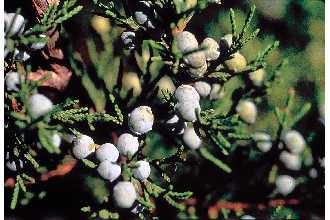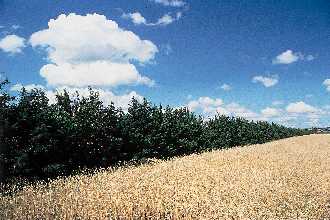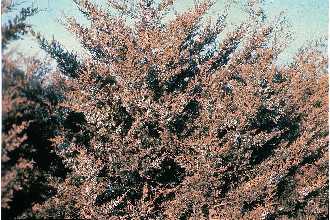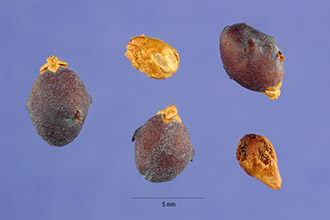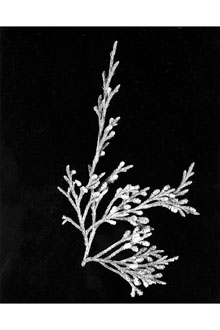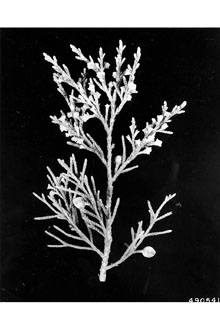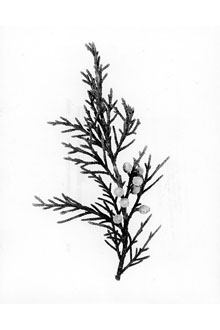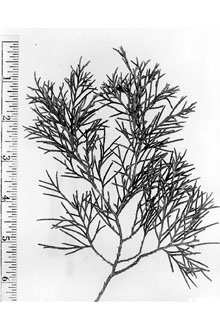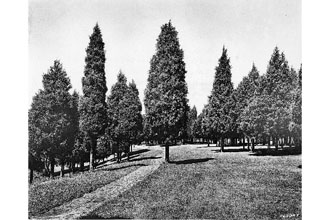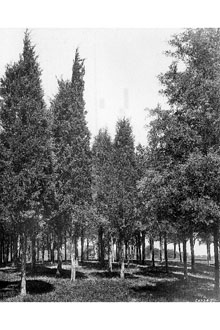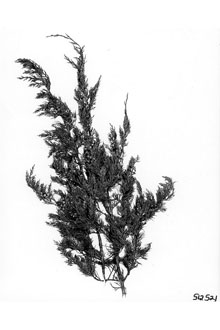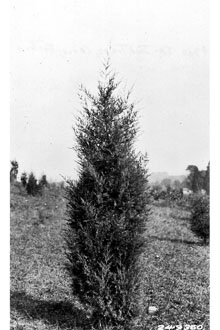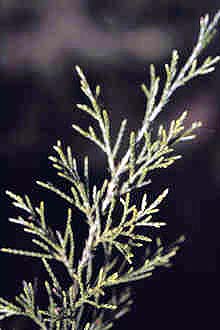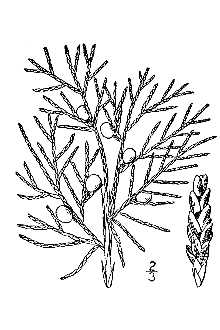Eastern Redcedar
Scientific Name: Juniperus virginiana L.
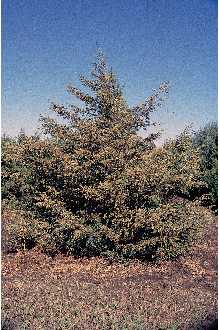
| General Information | |
|---|---|
| Usda Symbol | JUVI |
| Group | Gymnosperm |
| Life Cycle | Perennial |
| Growth Habits | Tree |
| Native Locations | JUVI |
Plant Guide
Alternative Names
Cedar tree, juniper, savin, evergreen, cedar apple, and Virginia red cedar
Uses
Ethnobotanic: The red cedar is used by many tribes for incense in purification and ritual (Kindscher 1992). For numerous tribes, the red cedar tree symbolizes the tree of life and is burned in sweat lodges and in purification rites. The Blackfeet made a tea from the berries of the red cedar to stop vomiting (Kindscher 1992). A blackfeet remedy for arthritis and rheumatism was to boil red cedar leaves in water, add one-half teaspoon of turpentine, and when cooled, rub the mixture on affected parts. The Blackfeet also drank a tea made from red cedar root as a general tonic; mixed with Populus leaves this root tea became a liniment for stiff backs or backache (McClintock 1909, Johnston 1970, Hellson 1974). Robert Molenbrock USDA, NRCS, Wetland Science Institute @ PLANTS The Cheyenne steeped the leaves of the red cedar and drank the resulting tea to relieve persistent coughing or a tickling in the throat. It was also believed to produce sedative effects that were especially useful for calming a hyperactive person. Cheyenne women drank the red cedar tea to speed delivery during childbirth (Grinnell 1962). The Cheyenne, along with the Flathead, Nez Perce, Kutenai, and Sioux, made a tea from red cedar boughs, branches, and fleshy cones, which they drank for colds, fevers, tonsillitis, and pneumonia (Hart 1976). As a cure for asthma, the Gros Ventres ate whole red cedar berries or pulverized them and boiled them to make a tea. They also made a preparation from the leaves mixed with the root, which they applied topically to control bleeding (Kroeber 1908). The Crows drank this medicinal tea to check diarrhea and to stop lung or nasal hemorrhage. Crow women drank it after childbirth for cleansing and healing (Hart 1976). The young leafy twigs of the red cedar were officially listed in the U.S. Pharmacopoeia from 1820 to 1894 as a diuretic (Kindscher 1992). The distilled oil of the red cedar has been officially listed as a reagent in the U.S. Pharmacopoeia since 1916 (ibid.). The wood of red cedar is very durable, and was used for lance shafts, bows, and other items. Flutes made from red cedar wood were highly regarded by the Cheyenne. Cedar boughs were used for bedding. The Menomini wove mats of cedar bark. The mats were used for roofing temporary structures, for partitions, floor mats and wrappings, and for various purposes in the canoes. Ornamental: Seedlings of red cedar are ordinarily used as stock for grafting ornamental juniper clones. Red cedars are often used as ornamentals for their evergreen foliage. Most cemetery plantings include old red cedar trees and many younger dwarf junipers. All of the native junipers are valuable ornamental species, and many horticultural varieties have been developed. Red cedar is widely used in shelterbelts and wildlife plantings. The close-grained, aromatic, and durable wood of junipers is used for furniture, interior paneling, novelties, and fence posts. The fruits and young branches contain aromatic oil that is used in medicines. Wildlife: Red cedar and other junipers are important to wildlife throughout the country. Their twigs and foliage are eaten extensively by hoofed browsers, but the chief attraction to wildlife is the bluish-black berry-like fruit. The cedar waxwing is one of the principal users of red cedar berries, but numerous other birds and mammals, both large and small, make these fruits an important part of their diet. In addition to their wildlife food value, cedars provide important protective and nesting cover. Chipping sparrows, robins, song sparrows, and mockingbirds use these trees as one of their favorite nesting sites. Juncos, myrtle warblers, sparrows of various kinds, and other birds use the dense foliage as roosting cover. In winter, their dense protective shelter is especially valuable.
Status
Please consult the PLANTS Web site and your State Department of Natural Resources for this plant’s current status, such as, state noxious status and wetland indicator values.
Description
General: Cypress Family (Cupressaceae). Red cedar (Juniperus virginiana) is a medium-sized dioecious or rarely monoecious tree from 10-20 m (33-66') tall (McGregor et al. 1986, Stephens 1973). The evergreen tree is shaped like a pyramid or column, with reddish-brown to grayish colored bark that is fibrous and shedding. Branches are usually reddish-brown. Leave are opposite, simple, green or blue-green, closely appressed and overlapping the leaf above, scale-like, and 0.2-0.3 cm (1/16-1/8”) long or needlelike and 0.6-1.2 cm (1/4-1/2”) long. Male and female cones are on separate trees. The staminate (male) cones are yellowish-brown, papery, solitary at the tips of branchlets, ovoid to ellipsoid, and 0.2-0.4 cm (1/16-1/8”) long. The ovulate (female) cones are solitary at the tips of branchlets, dark blue or bluish-purple, waxy and berrylike, 0.4-0.7 cm (3/16-1/4”) long. The female cones ripen from September through October. There are 1-3 seeds per cone. Red cedar seeds are yellow-brown and round, 2-4 mm in diameter, ridged near the base, and sometimes shallowly pitted.
Distribution
The distribution of red cedar (Juniperus virginiana) spans the U.S. east of the Rockies. The species also occurs in Oregon in the west. The southern red cedar (var. silicicola) occurs only in the southeastern US. For current distribution, please consult the Plant Profile page for this species on the PLANTS Web site.
Establishment
It is especially well adapted to dry areas. Red cedar is generally propagated by cuttings. Propagation from Cuttings Cuttings are made 5 to 15 cm (2 to 65 inches) long from new lateral growth tips stripped of older branches. A small piece of old wood, “a heel,” is thus left attached to the base of the cutting. Some propagators believe this to be advantageous. In other cases, good results are obtained when the cuttings are just clipped without the “heel” from the older wood. Cuttings from the current season’s terminal growth also root well. Cuttings to be rooted in the greenhouse can be taken at any time during the winter or rooted outdoors on heated beds. Exposing the stock plants to several hard freezes seems to give better rooting. Optimum time for taking cuttings is when stock plants have ceased growth (i.e. the late fall-winter propagation period is more successful than summer). For propagating in an outdoor cold frame, cuttings are taken in late summer or early fall. There may be advantages to using bottom heat. Lightly wounding the base of the cuttings is sometimes helpful, and the use of root-promoting chemicals, especially IBA, is beneficial. Recommendations for root-promoting chemicals include the following: 2500 IBA Quick-dip (Alabama), 3000 – 8000 ppm IBA liquid, and 0.3-4.5 percent IBA talc. Medium-coarse sand or a 10:1 mixture of perlite and peat moss is a satisfactory rooting medium. Maintenance of a humid environment without excessive wetting of the cuttings is desirable, as is a relatively high light intensity. A light, intermittent mist can be used. Bottom heat of 60-65°F (12°C) is critical the first six weeks of propagation to allow the basal wound of cuttings to callus.
Seed Propagation
Propagation
Propagation
Juniperus virginiana flowers from March to May. The fruits should be gathered in the fall (September-November) as soon as the berry-like cones become ripe. Red cedar trees come to seed-bearing age in 10 years, and they bear cones every 2-3 years. Seed collection can be done by stripping or picking the berries by hand from the trees, or by flailing the fruits to ground cloths. Be careful to pick only ripe berries. Since the number of filled seeds varies widely from tree to tree, it is important to test the seeds by cutting to determine percent fill. Seeds may be stored as berries or cleaned seeds. The seeds can be recovered by macerating the fruits and floating the seeds to the top. The addition of detergent to the maceration water helps to separate seeds from the resinous fruits. Red cedar seeds store quite well. They should be dried to 10-20% moisture and stored in a sealed container at cold temperatures. For best germination, seeds should be removed from the fruits, then the seed coat is softened by treating it with sulfuric acid for 120 minutes. After soaking the seeds in sulfuric acid, follow with 6 weeks of warm stratification at 20 to 30°C (70 to 85°F), or summer planting, then 10 weeks of pre-chilling at 4°C (40°F). Use of fresh seed reduced the warm stratification time. Rather than the acid treatment, two to three months of warm stratification could be used. As an alternative for cold stratification, the seed may be sown in the fall. Germination is delayed at temperatures above 15°C (60° F). Germination is often delayed in red cedar seeds, as seeds are consistently highly dormant. Red cedar seeds are usually sown in the nursery in the late summer or fall, but may be sown in spring or summer. The seeds of most species should be sown in fall to take advantage of natural pre-chilling. Red cedar seeds are usually drilled in well-prepared seedbeds in rows 15 to 20 cm apart and covered with 0.6 cm of soil. In nurseries with severe climates, such as those in the Great Plains, considerable care must be taken to protect the beds with mulch and snow fences. Viability of the seed varies considerably from year to year and among lots, but it is never much over 50 percent. Treated seed is usually planted in the spring, either in outdoor beds or in flats in the greenhouse. Two or three years are required to produce plants large enough to graft. Juniperus virginiana – 14-18 seeds per 110 kg fruit, 96 seeds per gram.
Management
The following information on the Traditional Resource Management (TRM) red cedar was provided by Lynn Youngbuck, who is Cherokee, Chiracahua, and Fox. TRM includes the following: • Take only what you need, leaving the best to reproduce. • Speak to the plant, leave an offering of tobacco or sage before harvesting. The plant will grow back two stems for every one cut. • Humans are another strand in life. Plants sustain us and should be treated as another living being. • Plants were taken care of by extended family groups of women. They were taken care of and watched each year for generations. • Materials harvested were shared and traded with the whole tribe. • Cedar bark was harvested in early June or early July as the bark is more easily removed at that season (Densmore 1974). The gathering of cedar bark was attended with a simple ceremony, followed by a feast. The next day the tree was cut. The bark was removed, and the tree was permitted to remain as it fell, and when thoroughly, dry was used for fuel. Cultivars, Improved and Selected Materials (and area of origin) JUVI is available through most nurseries.
Cultivars
include: Baker’s Blue, Blue Mountain, Brodie, Burkii, Canaerti, Cupressifolia, Dundee, Emerald Sentinel, Glauca, Gray Owl, Hillspire, Idyllwild, Manhattan Blue, Mission Spire, Nova, Pendula, Patt River, Princeton Sentry, Royo, Silver Spreader, Stover, and Taylor, Use soil moisture sensors to measure the soil moisture of Eastern Redcedar., Contact your local Natural Resources Conservation Service (formerly Soil Conservation Service) office for more information, Look in the phone book under ”United States Government,” The Natural Resources
Conservation
Service will be listed under the subheading “Department of Agriculture.”
References
Andros, F. 1883. The medicine and surgery of the Winnebago and Dakota Indians. American Medical Association Journal 1:116-118. Carlson, G.G. & V.H. Jones 1939. Some notes on use of plants by the Comanche Indians. Michigan Academy of Science, Arts, and Letters 25:517-543. Densmore, F. 1974. How Indians use wild plants for food, medicine, and crafts. Dover Publications, Inc., New York, New York. 397 pp. Grinnell, G.B. 1962. The Cheyenne Indians. 2 Vols. Cooper Square Publishers, New York, New York. Hart, J. A. 1976. Montana native plants and early peoples. Montana Historical Society, Helena, Montana. Hartmann, H.T., D.E. Kesler, & F.T. Davies, Jr. 1990. Plant propagation principles and practices. Prentice Hall, Englewood Cliffs, New Jersey. 647 pp. Hellson, J.C. 1974. Ethnobotany of the Blackfoot Indians. National Museum of Man, Mercury Series, Canadian Ethnology Service Paper No. 19. Johnston, A. 1970 . Blackfoot Indian utilization of the flora of the northwestern Great Plains. Economic Botany 24:301-24. Kindscher, K. 1992. Medicinal wild plants of the prairie. An ethnobotanical guide. University Press of Kansas. 340 pp. Kindscher, K. 1987. Edible wild plants of the prairie. An ethnobotanical guide. University Press of Kansas. 276 pp. Kroeber, A.L. 1908. The ethnology of the Gros Ventre. American Museum of Natural History, Anthropological Papers 1:145-281. Martin, A.C., H.S. Zim, & A.L. Nelson 1951. American wildlife and plants: A guide to wildlife food habits. Dover Publications, Inc., New York, New York. 500 pp. McClintock, W. 1909. Materia medica of the Blackfeet. Zeitschrift fur Ethnologie: 273-279. McGregor, R.L., T.M. Barkley, R.E. Brooks, & E.K. Schofield (eds.) 1985. Flora of the Great Plains. Great Plains Flora Association. University Press of Kansas. 1402 pp. Moore, M. 1979. Medicinal plants of the mountain west. Museum of New Mexico Press. 200 pp. Smith, H.H. 1928. Ethnobotany of the Meskwaki Indians. Bulletin of the Public Museum of the City of Milwaukee 4(2):175-326. Stephens, H.A. 1973. Woody plants of the north central plains. The University Press of Kansas. 530 pp. Tilford, G.L. 1997. Edible and medicinal plants of the west. Mountain Press Publishing Company, Missoula, Montana. Vestal, P.A. & R.E. Schultes 1939. The economic botany of the Kiowa Indians. Botanical Museum, Harvard University, Cambridge, Massachusetts. Young, A.J. & C.G. Young 1992. Seeds of woody plants in North America. Dioscorides Press, Portland, Oregon.
Fact Sheet
Uses
Windbreaks: Plant eastern redcedar in the outer rows of multi-row plantings where it will not be overtopped by taller trees. It can be used in single-row windbreaks when a dense, medium height barrier is desired. Wildlife: This species provides food and cover for numerous birds and mammals. Winter food and protection is particularly important for pheasant, mule deer and whitetail deer. Recreation and Beautification: It is suitable for screen plantings. Its year-long coloration and attractiveness to wildlife adds variety to recreational plantings.
Status
Please consult the PLANTS Web site and your State Department of Natural Resources for this plant’s current status (e.g. threatened or endangered species, state noxious status, and wetland indicator values).
Description
Juniperus virginiana L., eastern redcedar, is a small evergreen tree, commonly 10 to 40 feet, of pyramidal shape becoming rounder in age. Fruits pale-blue with whitish bloom, fleshy ‘berries’ (cones), 1/4 inch diameter, ripening the first season, seeds 1 to 2 in each cone, bony-coated; flowers small, cone-like on end of short twigs, male and female borne on separate plants. Leaves opposite, scalelike, covering older twigs closely in alternating pairs to 1/8 inch long, on new shoots awl shaped, sharp pointed and spreading, 1/4 inch long, dark green. Stem single with upright or spreading branches, bark reddish-brown, thin and shreddy, branchlets very slender; roots deep, widely spreading.
Adaptation and Distribution
Distribution
Distribution
It is native to eastern North America, where it occurs strongly on limestone derived soils. and is cultivated in Wyoming and Colorado for shelterbelts and ornamental uses below 6,000 feet. This species has a wide distribution and is found on many types of soil ranging from acid sands to those derived from limestone. It does best on dry soils in full sunlight, and is winter hardy and tolerant of droughty and salty soils. Like most junipers, it is very slow growing and is moderately long lived. Robert H. Mohlenbrock USDA NRCS 1991 Southern Wetland Flora @USDA NRCS PLANTS Eastern redcedar is distributed throughout the east , and lower and upper midwest. For a current distribution map, please consult the Plant Profile page for this species on the PLANTS Website.
Establishment
Seedlings should be planted in a firm weed free bed at a spacing of 3 to 6 feet. Seedlings should be placed in a hole or furrow large enough to contain the entire root system without bending.
Management
Weed and other competing vegetation must be controlled the first two years of establishment, This plant will survive in moist, deep loam to sand at pH of 6,0 to 8,0, will tolerate alkaline and saline conditions, Use soil moisture sensors to measure the soil moisture of Eastern Redcedar., This plant is invasive in poorly managed or extensively grazed pastures and rangelands, especially those with neutral pH soils,
Plant Traits
Growth Requirements
| Temperature, Minimum (°F) | -43 |
|---|---|
| Adapted to Coarse Textured Soils | Yes |
| Adapted to Fine Textured Soils | Yes |
| Adapted to Medium Textured Soils | Yes |
| Anaerobic Tolerance | Low |
| CaCO3 Tolerance | High |
| Cold Stratification Required | Yes |
| Drought Tolerance | High |
| Fertility Requirement | Low |
| Fire Tolerance | Low |
| Frost Free Days, Minimum | 140 |
| Hedge Tolerance | Medium |
| Moisture Use | Low |
| pH, Maximum | 8.0 |
| pH, Minimum | 4.7 |
| Planting Density per Acre, Maxim | 1200 |
| Planting Density per Acre, Minim | 300 |
| Precipitation, Maximum | 68 |
| Precipitation, Minimum | 15 |
| Root Depth, Minimum (inches) | 20 |
| Salinity Tolerance | Low |
| Shade Tolerance | Intermediate |
Morphology/Physiology
| Bloat | None |
|---|---|
| Toxicity | Slight |
| Resprout Ability | Yes |
| Shape and Orientation | Conical |
| Active Growth Period | Spring and Summer |
| C:N Ratio | High |
| Coppice Potential | No |
| Fall Conspicuous | No |
| Fire Resistant | No |
| Flower Color | Green |
| Flower Conspicuous | No |
| Foliage Color | Green |
| Foliage Porosity Summer | Dense |
| Foliage Porosity Winter | Dense |
| Foliage Texture | Medium |
| Fruit/Seed Conspicuous | Yes |
| Nitrogen Fixation | None |
| Low Growing Grass | No |
| Lifespan | Moderate |
| Leaf Retention | No |
| Known Allelopath | Yes |
| Height, Mature (feet) | 50.0 |
| Height at 20 Years, Maximum (fee | 25 |
| Growth Rate | Slow |
| Growth Form | Single Stem |
| Fruit/Seed Color | White |
Reproduction
| Vegetative Spread Rate | None |
|---|---|
| Small Grain | No |
| Seedling Vigor | Low |
| Seed Spread Rate | Rapid |
| Seed per Pound | 43600 |
| Fruit/Seed Persistence | Yes |
| Propagated by Tubers | No |
| Propagated by Sprigs | No |
| Propagated by Sod | No |
| Propagated by Seed | Yes |
| Propagated by Corm | No |
| Propagated by Cuttings | Yes |
| Bloom Period | Late Spring |
| Commercial Availability | Routinely Available |
| Fruit/Seed Abundance | Medium |
| Fruit/Seed Period Begin | Summer |
| Fruit/Seed Period End | Fall |
| Propagated by Bare Root | Yes |
| Propagated by Bulb | No |
| Propagated by Container | Yes |
Suitability/Use
| Veneer Product | Yes |
|---|---|
| Pulpwood Product | No |
| Protein Potential | Low |
| Post Product | Yes |
| Palatable Human | No |
| Palatable Graze Animal | Low |
| Palatable Browse Animal | Low |
| Nursery Stock Product | Yes |
| Naval Store Product | No |
| Lumber Product | No |
| Fuelwood Product | Medium |
| Fodder Product | No |
| Christmas Tree Product | Yes |
| Berry/Nut/Seed Product | No |

